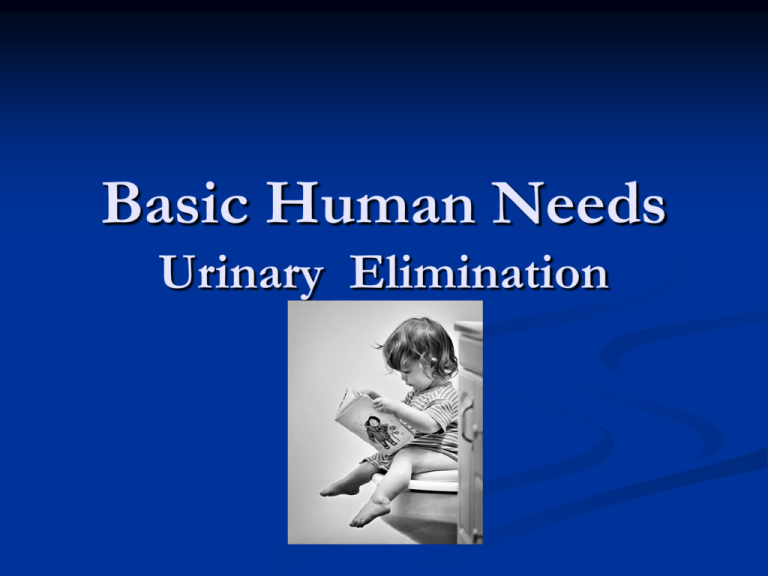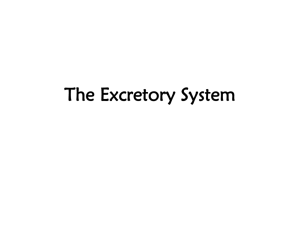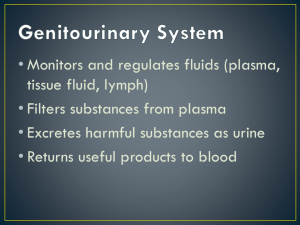
Basic Human Needs
Urinary Elimination
Urinary Elimination
Basic function that is taken for granted
When the urinary system fails to function
properly, all organ systems will be affected
Urinary elimination depends on the function of
the kidneys, ureters, bladder, & urethra
Kidneys
Paired, reddish, brown bean shaped organs
Location: 12th thoracic vertebrae to 3rd Lumbar
Left kidney is 1.5 to 2 cm higher than right, 12 x 7 cm
Weight: 120-150 gms
Covered by tough capsule and cushioned by fat
Kidneys
Waste products filtered through kidneys
Blood reached kidney via renal artery
20-25% of cardiac output circulates to kidneys
(1200ml/min)
Anatomy of Kidney
Nephron-Functional unit of kidney, forms urine
Each kidney has 1 million nephrons
Nephron composed of glomerulus, Bowman’s capsule,
proximal convoluted tubule, loop of Henle, distal
tubule, & collecting tubule
Blood Supply
Blood reaches kidney via renal artery
Arises from aorta, enters kidney at hilus
Renal artery divides into secondary branches,
then into smaller braches to afferent arteriole
Blood Supply
To Kidney: Afferent arteriole divides into a capillary
network called glomerulus
From Kidney: The capillaries unite to form the Efferent
arteriole which splits to form peritubular capillaries,
drain into venous system > renal vein > inferior vena
cava > heart
Physiology of Urine Formation
Normal glomerular function- Urine formation starts at
glomerulus where blood is filtered
GFR-(Glomerular filtration rate)- amt of blood filtered
by glomeruli in a given time
Normal GFR- 125ml/minute, however only 1 ml per
minute becomes urine, most is reabsorbed
Tubular Function
Reabsorption-refers to the passage of a substance from
the lumen of the tubules through the tubule cells and
into the capillaries
Tubular Secretion-passage of a substance from the
capillaries through the tubular cells and into the lumen
of the tubule
Tubular Function
Proximal Convoluted Tubule- 80% of electrolytes,
glucose, amino acids, protein, reabsorbed Hydrogen &
creatinine are secreted into filtrate
Loop of Henle - Important in conserving water,
reabsorption continues, Descending loop-reabsorption
of H2O, Ascending loop- reabsorption of Na & Cl
Tubular Function
Distal Convoluted Tubule- Final regulation of water
balance & acid-base balance. Requires ADH (antidiuretic hormone) for water reabsorption & aldosterone
for Na & Cl reabsorption
Stimulus for ADH secretion: high serum osmolality,
low blood volume
Aldosterone secretion influenced by circulating blood
volume, plasma concentration of Na &Cl
Tubular Function
Distal Tubule: Acid-Base regulation involves
reabsorbing and conserving Bicarb and excretion of
excess hydrogen to maintain blood pH at 7.35-7.45
99% of filtrate is reabsorbed into plasma, 1% excreted
as urine
Normal 24 hr urine output is 1500-1600ml
Hormone Production
Erythropoietin
Renin
Angiotensinogen
Kidneys also play a role in Calcium & Phosphate
regulation,convert Vitamin D to active form
Ureters
Enter renal pelvis from collecting ducts
A ureter joins each renal pelvis to bladder
Tubular structures, 10-12 cm long
Peristaltic waves move urine to bladder
Obstruction of ureters-renal calculi, strong peristaltic
wave-renal colic
Bladder
Hollow,distensible, muscular organ (4 layers of muscle)
Reservoir for urine
Organ of excretion
Expands as it becomes filled with urine
Pressure within bladder is low
600ml capacity, normal voiding 300ml
Bladder
Trigone-base of bladder
Muscular layer-detrusor muscle
Parasympathetic innervation stimulates detrusor
during urination (smooth muscle contraction)
resulting in bladder emptying
Bladder
External Sphincter control under voluntary control
Sympathetic innervation cause smooth muscle
relaxation allowing bladder to fill
Internal Sphincter (involuntary) controlled by SNScause urethrea to remain closed until person is ready to
void
Control of Micturition is a result of coordination
between the opening of the sphincters and contraction
of detrusor
Urethra
Urine travels from the bladder through the urethra &
passes outside the body through the urethral meatus
Lined by mucus membranes, bacteriostatic, forms
mucus plug
Women-1.5-2.5 inches long, external sphincter allows
voluntary flow of urine, prone to infection
Urethra
Men-Urethra is both a urinary canal and a
passageway for secretions form reproductive
organs
20cm in length
Clicker Question
1. A client with long-standing history of
diabetes mellitus is voicing concerns about
kidney disease. The client asks the nurse where
urine is formed in the kidney. The nurse’s
response is the:
A. Glomerulus
B. Kidney
C. Nephron
D. Ureter
45 - 26
Act of Urination
Controlled by brain
Coordination of cerebral cortex, thalamus,
hypothalamus, & brain stem
Suppress contraction of bladder’s detrusor until
person is ready to void
Act of Urination
Bladder normally holds as much as 600 ml of urine
Desire to void is felt(sensed) when bladder contains a
smaller amount (150-200ml in adult)
As bladder volume increases, bladder walls stretch,
sending sensory impulses to micturition center in sacral
spinal cord
Act of Urination
Parasympathetic impulses from the micturition center
stimulate detrusor muscle to contract
Internal sphincter relaxes so urine can enter urethra
As bladder contracts, nerve impulses travel up spinal
cord to the cerebral cortex, now you are aware of the
urge to void
Factors Influencing Urination
Disease
Growth & Development
Sociocultural factors
Psychological Factors
Muscle Tone
Fluid Balance
Surgery
Medications
Disease
Pre-renal
Renal
Post-renal
Pre-Renal Disease
Alterations in urinary elimination resulting from
a decrease in circulating blood flow to and
through the kidneys with a resultant decrease in
perfusion to renal tissue
Alteration is outside the urinary system
Pre-Renal Disease
Decrease in renal perfusion leads to oliguria
(diminished capacity to form urine) or anuria
(inability to produce urine)
Pre-renal Conditions
Decreased intravascular volume
Dehydration
Hemorrhage
Shock
Sepsis
Anaphylactic Reactions
Cardiac Pump Failure
Renal Disease
Result from factors that cause injury directly to
glomeruli or renal tubule, interfering with
normal filtration, reabsorption, & secretory
functions
Renal Conditions
Nephrotoxic agents (aminoglycoside antibiotics)
Blood transfusion reaction
Disease of glomeruli
Renal tumors
Systemic disease (Diabetes)
Infection
Hereditary disease (Polycystic kidney disease)
Post-Renal disease
Result from obstruction of urinary collecting
system from kidney to urethral meatus
Urine is formed but cannot be eliminated
Post-Renal Conditions
Obstruction due to calculi, blood clots, tumors,
or stricture
Prostatic hypertrophy or tumor
Neurogenic bladder
Pelvic tumors
Renal Disease
Diseases that cause irreversible damage to the
glomerulus or tubules result in permanent
alterations in renal function
Chronic Renal Disease
End Stage Renal Disease
Needs treatment for survival
Uremic Syndrome
Decreased urine output
Proteinuria
Volume overload
CHF
Dysrhythmias
N/V
Uremic frost
Anemia
Renal Disease Labs
Elevated BUN (7-26 mg/dl)
Elevated creatinine (0.7-1.5 mg/dl)
Elevated potassium (3.5-5.1 mmol/L)
Elevated phosphate (2.4-4.4 mg/dl)
Decreased calcium (8.6-10.6 mg/dl)
Decreased HCO3 and pH (22-26, 7.35-7.45)
Uremic Syndrome
Increase in nitrogen waste in blood
Fluid and electrolyte disturbance
Treatment either conservative or aggressive
Renal Disease Treatment
Conservative- meds, diet & fluid restriction
Aggressive- Renal Replacement Therapies:
Dialysis (Peritoneal or Hemodialysis)
Organ transplantation
Dialysis
Peritoneal-Indirect method of cleansing blood
of waste products using the process of osmosis
and diffusion
Hemodialysis-machine process utilizes osmosis,
diffusion, & ultrafiltration through a vascular
graft (Udall, TESIO, Permcath, Shiley)
Index
Organ Transplantation
Replacement of diseased kidney with a healthy
one
Compatible blood and tissue type
Sharing Network
Organ Donation card
Factors Influencing Urination:
G&D
Infants & young children cannot effectively
concentrate their urine
Older adult: difficulty with urination, GFR
declines. Kidney’s ability to concentrate urine
declines
Nocturia, urinary frequency
BPH in men
Residual urine (UTI’s)
Factors Influencing
Urination:Sociocultural
Private toilet facilities (American) communal
(Europe)
Social expectations influence time of urination
Must consider cultural, social and gender habits
Factors Influencing Urination:
Psychological
Anxiety and emotional stress may cause sense of
urgency and increase frequency of urination
Need to relax to void
Factors Influencing Urination:
Muscle Tone
Weak abdominal & pelvic floor muscles impair
bladder contraction and control of external
sphincter
Prolonged immobility, stretching of muscles,
menopausal muscle atrophy, damage from
trauma, long term catheter use
Factors Influencing Urination:
Fluid Balance
Ingested fluids increase body’s circulating plasma
volume which increase urine output
Increased urine formation: coffee, tea, cola drinks
Caffeine is a bladder irritant as well as a diuretic
Alcohol inhibits the release of ADH resulting in
increased water loss in urine
Factors Influencing Urination:
Surgery
Triggers General Adaptation Syndrome ( Increase water
reabsorption, reduces urine output
Stress response causes increased aldosterone resulting
in decreased urine output
Anesthetics & narcotics slow GFR decreasing urine
output, risk for urinary retention with spinal anesthesia
(post-op patients may require hourly urine outputs or if
unable to void after surgery, straight catheterization)
Factors Influencing Urination:
Medications
Diuretics prevent reabsorption of water and
certain electrolytes to increase urine output
Urinary retention caused by antihistamines
(Sudafed), antihypertensives (Aldomet), & beta
blockers (Inderal)
Change color of urine-Pyridium
Clicker Question
A young girl is having problems urinating
postoperatively. You remember that children
may have trouble voiding:
A. In bathrooms other than their own
B. In a urinal
C. While lying in bed
D. In the presence of person other than their
parents
45 - 60
Alterations in Urinary
Elimination
Urinary Retention
Urinary Tract Infections
Urinary Incontinence
Urinary Diversions
Urinary Retention
Marked accumulation of urine in bladder as a result of
the inability of the bladder to empty
Bladder not able to respond to micturition reflex and
empty
Retention with overflow may develop, small amt of
urine escapes, bladder spasms
S&S of bladder distention- discomfort, diaphoresis,
restlessness
Lower Urinary Tract Infection
7 million office visits a year
Most common nosocomial infection on U.S.
Most from catheterization or surgery
Bacteria in the urine may lead to the spread of
organisms into bloodstream (Urosepsis)
UTI Symptoms
Pain or burning on urination (dysuria)
Fever, chills, n/v, malaise (later signs)
Hematuria-irritation of bladder & urethral
mucosa resulting in blood-tinged urine
Pyelonephritis-infection spreads up to kidneyflank pain, fever
Urinary Incontinence
Involuntary loss of urine that is a sufficient
problem
Temporary or Permanent
No longer have control over micturition
Leakage can be intermittent or continuous
Urinary Incontinence
Functional
Overflow
Reflex
Stress
Urge
Urinary Diversions
Urinary stoma to divert urine from kidneys
directly to abdominal surface
Ileal Conduit
Continent Pouch
Ureterostomy
Nephrostomy
Reasons for Diversions
Cancer (Bladder, Prostate, Pelvis, Cervix)
Radiation injury
Vesicovaginal fistula
Neurogenic bladder
Chronic cystitis
Painful Bladder Syndrome/Interstitial Cystitis
Clicker Question
A health care provider may suspect that a client
is experiencing urinary retention when the client
has:
A. Large amounts of voided cloudy urine
B. Pain in the suprapubic region
C. Small amounts of urine voided 2 to 3 times
per hour
D. Spasms and difficulty during urination
45 - 77
Nursing Process
Alterations in Urinary Function
Assessment: Nursing history
Physical Assessment-inspection, percussion, palpation
Assessment of Urine- color, clarity, odor
Urine testing & specimen collection
Diagnostic tests: KUB, IVP, renal ultrasound, renal CT
scan
Invasive-Cystoscopy, arteriogram, urodymanics
Urine Specimen Collection
Random
Clean-voided or midstream
Sterile
Timed specimens (24 hour collection)
Urine Testing
Uninalysis
Specific Gravity
Urine Culture
Nursing Diagnosis
Incontinence
Self-Care deficit
Skin Integrity
Altered Urinary Elimination
Pain
Body Image Disturbance
Implementation
Promoting Normal Micturition
Medications
Catheterization (Indwelling vs. straight)
Catheter Irrigations & Instillations
Routine Catheter Care/Perineal Care
Suprapubic Catheterization
External Urinary Cathethers (Condom caths)
Female Urinals
Maintaining Skin Integrity
Preventing Infection
Last Updated: April 1, 2005
Foley catheter
Illustration copyright 2004 Nucleus Communications, Inc. All rights reserved. http://www.nucleusinc.com
An indwelling Foley catheter remains in place continuously. To keep the catheter from slipping out, there is a balloon on one end that is inflated with sterile water once that end is inside
the bladder.
Medical Review:
Last Updated:
Adam Husney, MD - Family Medicine
Nancy Greenwald, MD - Physical Medicine and Rehabilitation
April 1, 2005








